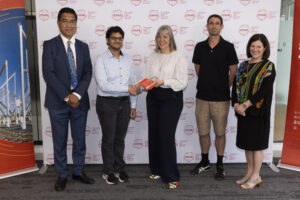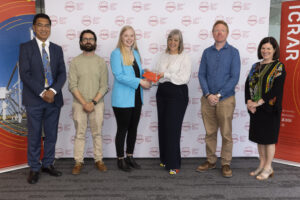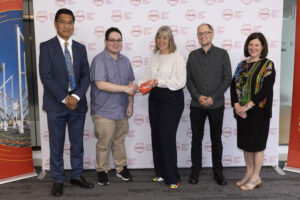THE KEN AND JULIE MICHAEL PRIZES RECOGNISE THE OUTSTANDING ACHIEVEMENTS OF OUR GRADUATE STUDENTS AT BOTH ICRAR NODES.
The 2022 award recipients are joint winners from both nodes.
Torrance Hodgson and Jishnu Thekkeppattu from ICRAR-Curtin and Jessica Thorne and Mitchell Cavanagh from ICRAR-UWA.
TORRANCE HODGSON:
Torrance’s doctoral research sought to detect the synchrotron cosmic web primarily using the MWA and produced model simulations to help understand and guide future detection work. Torrance who is originally from Aotearoa/New Zealand, completed a Bachelor’s with honours (Maths & Physics) at Victoria University of Wellington, and he also holds a Masters in Sociology. Torrance originally came to Curtin to do a PhD on invitation from Melanie Johnston-Hollitt and he is currently working at the Curtin Institute of Computation on high performance radio astronomy imaging.

JISHNU THEKKEPPATTU:
Jishnu joined the Epoch of Reionization (EoR) group at ICRAR-Curtin in November 2019 for his PhD, supervised by Cathryn Trott and Benjamin McKinley. His doctoral work focused on experimental cosmology, combining low frequency radio instrumentation with astronomy and cosmology. His specialisation is in designing and commissioning experiments targeting the global 21-cm signal from the cosmic dawn and epoch of reionization (CD/EoR), as well as analysing data from them. During his doctoral studies, he carried out a detailed characterisation of the SARAS-3 cosmic dawn experiment qualifying it for cosmological observations. He also played a significant role in the analysis of SARAS-3 data that resulted in a non-detection of the absorption trough reported by the EDGES experiment. He also led the design and commissioning of SITARA, an interferometric global 21-cm experiment that takes advantage of the coherence enhancement offered by short-spacing interferometers to an all-sky signal. SITARA, which is deployed at the MRO, carries out broadband observations of the low frequency radio sky day and night. Leveraging the reliability of the SITARA system, he combined a time series analysis technique with low frequency radio data to develop a novel method to characterise, and potentially calibrate, radio telescopes.
Jishnu submitted his thesis in July 2022 and currently works as a research associate with the astronomical instrumentation group at ICRAR-Curtin. Outside of work he is also an avid radio amateur holding an advanced licence, and regularly takes part in amateur radio contests and field days.

JESSICA THORNE:
Jessica’s research has been focused on pushing the limits of current galaxy spectral energy distribution (SED) fitting techniques to extract as much information from panchromatic galaxy surveys as possible. This includes exploring the ability to measure metallicities and detect active supermassive black holes from galaxy SEDs. Jess has applied these SED fitting techniques to a sample of ~700,000 galaxies to study the evolution of stellar mass, metallicity, and star formation rate over the last 8 billion years. Recently, she has been working on extending traditional ultraviolet to infrared fitting techniques to radio frequencies to combine incoming data from the SKA pathfinders with large galaxy surveys such as GAMA and DEVILS. She has written three first-author papers during her PhD with a fourth to be submitted soon and has co-authored a further 16, ranging from simulations to X-ray and radio observations. Both her first-authored and co-authored papers are being regularly cited, with over 300 citations already.

MITCHELL CAVANAGH:
Mitchell’s doctoral research is focused on the applications of machine learning to study the evolution of galaxy morphologies. He has developed a suite of convolutional neural networks to classify galaxies into various morphological types (elliptical, lenticular, etc.), and has applied these models to classify tens of thousands of galaxies from surveys such as the SDSS, SAMI and COSMOS, as well as images of mock galaxies from the EAGLE cosmological simulation. In particular, Mitchell has used his models to study how the fraction of barred galaxies changes over time in EAGLE, and he has analysed the redshift evolution of the fraction of lenticular galaxies in COSMOS. As part of his PhD, he has published two first-author papers and has recently submitted a third. He hopes to continue expanding the capabilities of his models and develop models for other tasks, such as morphological segmentation.
Mitchell has long had a keen interest in space and astronomy, as well as all things technology related. He completed undergraduate studies in both Physics and Computer Science, and this path led to his current interest in machine learning. Outside of his research, he is an avid reader of science fiction, enjoys programming, and loves learning languages.
Congratulations to the winners and their supervisors, and to all the applicants for their achievements. Thanks to Dr Ken Michael for his generous support for this Prize, first awarded in 2017 to Chenoa Tremblay & Tristan Reynolds, in 2018 to Ahmed Elagali & Sam McSweeney, in 2019 to Mengyao Xue & Fei Qin, in 2020 to Dr Pikky Atri, Dr Kate Harborne & Benjamin Dix-Matthews and in 2021 to Stefan Duchesne, James Buchan & Ruby Wright.

